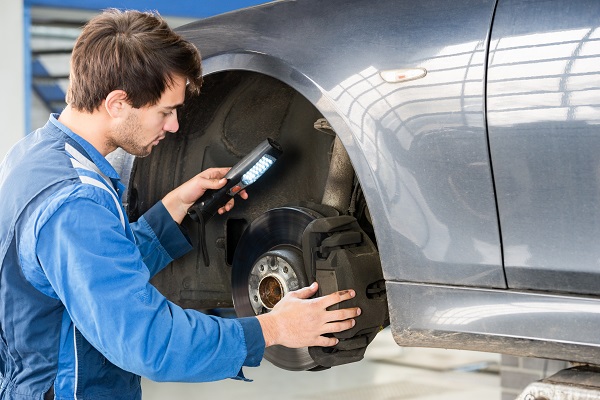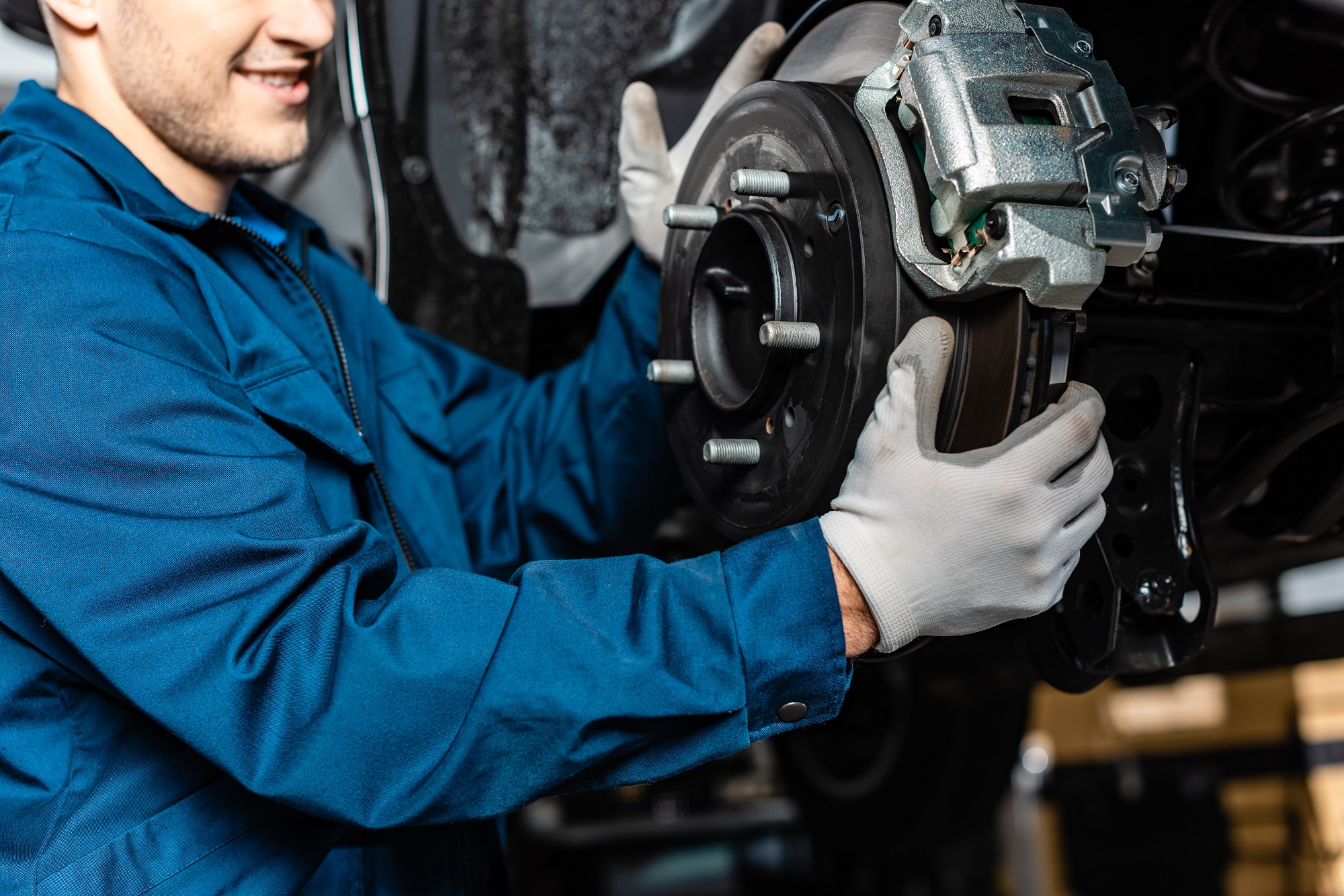Recognizing the Warning Signals for Safe Driving
You need a brake inspection if you notice unusual noises when braking, like squealing or grinding. These signs may indicate you need brake repair. Dashboard warning lights, such as the brake or ABS light, also signal issues. A spongy or soft brake pedal, along with vibrations during braking, indicates potential problems like air in the lines or warped rotors. If your vehicle pulls to one side, uneven brake wear might be the cause. Don’t ignore low or dirty brake fluid, as it can compromise system effectiveness. Recognizing these signs early can prevent costly repairs and ensure your safety—explore further to understand the importance of regular inspections.
Unusual Noises When Braking
When you hear unusual noises while braking, it’s crucial to pay attention, as these sounds often indicate underlying issues that need immediate attention.
High-pitched squealing typically signals worn brake pads, requiring replacement to ensure effective braking performance.
If you notice a grinding sound, it suggests metal-on-metal contact, which can severely damage your rotors if not addressed quickly.
Additionally, clicking or clunking noises may indicate loose or damaged brake components, necessitating an immediate inspection for safety.
An increase in noise frequency when applying the brakes points to emerging issues with your brake components that demand a brake repair specialist evaluation.
Ignoring these unusual noises can lead to more extensive damage and increased repair costs, emphasizing the importance of timely inspections.
Warning Lights on Dashboard
Dashboard warning lights serve as critical indicators of your vehicle’s braking system health. An illuminated brake warning light means there’s a malfunction that requires immediate attention.
This light could signify various issues, including low brake fluid levels, which might indicate a leak or that you need to top it up. Also, pay attention to the ABS light; its illumination suggests potential problems with the Anti-lock Braking System, which can compromise your braking performance, especially during emergency stops.
Ignoring these warning lights can lead to severe consequences, including brake failure, posing significant risks to your safety. Regularly monitor your dashboard indicators to ensure your vehicle’s braking system functions optimally and safely.
Spongy or Soft Brake Pedal
A spongy or soft brake pedal can signal serious issues within your vehicle’s braking system. This condition often indicates air in the brake lines, potentially compromising your braking effectiveness.
It can also result from brake fluid leaks or contamination, making immediate professional inspection crucial to avoid brake failure. If you notice a soft brake pedal, take the following steps:
Step 1: Check brake fluid levels – Ensure they’re within the recommended range.
Step 2: Inspect the master cylinder – Look for any signs of leaks or malfunction.
Step 3: Prioritize brake maintenance – Regularly replace worn components with your professional team at Springs Brake and Suspension to prevent issues.
Addressing these factors promptly can enhance your vehicle’s safety and performance, reducing the risk of accidents due to delayed stopping.
Vehicle Pulling to One Side
If your vehicle pulls to one side during braking, it’s crucial to address the issue promptly.
This pulling effect often indicates an imbalance in the brake system, typically caused by uneven brake wear or faulty calipers. Ignoring these warning signs can lead to increased stopping distances, significantly compromising your safety.
Regular brake inspections are essential for identifying underlying issues, ensuring all components function evenly. If you notice your vehicle pulls to one side, schedule an immediate inspection with Springs Brake and Suspension to diagnose and rectify the cause.
Prolonging this issue can result in more severe brake component damage and costly repairs down the line. Don’t overlook this symptom—maintaining optimal brake performance is vital for safe driving.
Vibrations During Braking

Experiencing vibrations during braking can signal significant issues within your brake system, often related to warped rotors or uneven brake pads. Ignoring these vibrations can compromise your vehicle control and lead to further damage.
Here are three key points to consider:
- Warped Rotors: These can cause inconsistent brake pressure, leading to vibrations felt through the pedal.
- Uneven Brake Pads: Worn or improperly aligned pads can create instability during braking, exacerbating vibrations.
- Immediate Inspection: If you notice persistent vibrations, it’s crucial to schedule a professional inspection to prevent further degradation of your brake system.
Addressing vibrations during braking promptly ensures optimal vehicle performance and safety on the road.
Grabbing or Jerking Sensation
Noticing a grabbing or jerking sensation when you apply the brakes can be alarming, as it often signals serious issues within your braking system. This sensation typically indicates warped brake rotors or malfunctioning brake calipers that require immediate quality service.
If left unaddressed, it can lead to uneven wear on brake components, increasing repair costs and compromising safety. The grabbing might also stem from contaminated brake fluid, affecting the hydraulic system and overall braking efficiency.
Ignoring this issue can extend stopping distances and heighten the risk of accidents. To maintain safe driving conditions, schedule regular brake inspections to identify problems like grabbing early, ensuring your brake pads and other components function effectively.
Do You Need Brake Repair or Inspection Service?
Don’t wait—schedule your brake service appointment today!
Low or Dirty Brake Fluid
Low or dirty brake fluid can significantly impact your vehicle’s braking performance and safety.
It’s crucial to regularly check your brake fluid to avoid serious issues. Here are three key indicators that you need to inspect your brake fluid:
- Low fluid levels: A drop in brake fluid can indicate leaks in the brake system, which may compromise braking effectiveness.
- Dirty or dark fluid: Brake fluid should be a golden yellow; dark or contaminated fluid signals a need for replacement to maintain hydraulic function.
- Corrosion risk: Brake fluid absorbs moisture over time, leading to corrosion and reduced performance.
Regular professional brake maintenance with Springs Brake, including fluid checks and inspections, ensures your brake system operates optimally and safely.
Changes in Brake Response
Maintaining proper brake fluid levels is vital for optimal performance, but changes in how your brakes respond can signal deeper issues.
If your brake pedal feels soft or spongy, it may indicate air in the brake lines or a fluid leak, necessitating immediate evaluation. A noticeable increase in stopping distance often points to worn brake components or low brake fluid.
Additionally, if your vehicle pulls to one side during braking, it suggests uneven brake wear or malfunctioning calipers, requiring a thorough inspection.
Be alert for warning lights on your dashboard, as they’re crucial signs that your brakes need attention.
Always visually inspect your brakes for any noticeable wear or damage, ensuring your safety on the road.
Get Regular Inspection Recommendations from the Professionals at Springs Brake and Suspension
Regular brake inspections are crucial for ensuring your vehicle’s safety and performance. At Springs Brake and Suspension, we recommend getting a brake check early to identify any issues.
Here are three signs you need to schedule an inspection:
- Unusual brake noises when braking, indicating it’s time to replace brake pads.
- If your vehicle pulls to one side while braking, it may suggest uneven wear or caliper issues.
- A spongy or low brake pedal can signal underlying hydraulic problems.
Our brake technicians specializes in comprehensive quality brake repair services that address these concerns. We provide excellent customer service.
By prioritizing regular inspections, you can maintain your vehicle’s braking efficiency and ensure safe driving on the road.
Auto repair services we provide
- Suspension Services in Vancouver: Our suspension services ensure that your vehicle’s ride quality and handling are optimized.
- Lift Kit Installation in Vancouver: Enhance your vehicle’s off-road capability and aesthetics with our professional lift kit installation.
- Power Steering Repair in Vancouver: Our power steering repair services diagnose and fix issues with your steering system.
- Alignment Services in Vancouver: Our alignment services help to correct your vehicle’s wheel angles, leading to improved tire wear, enhanced fuel efficiency, and a straight driving experience.
Meet the Owner: Sean Miller

Sean Miller is the dedicated owner of Springs Brake and Suspension, a local auto repair shop known for its exceptional service and expertise. Prior to acquiring the business, Sean gained valuable experience working with Fortune 500 companies and federal governments, developing innovative business models, while also running a successful auto detailing venture as a hobby. His strong business skills and a genuine commitment to customer satisfaction have made Springs a go-to spot for both car enthusiasts and everyday drivers. Outside of work, Sean enjoys attending car shows, exploring new automotive technologies, and mentoring aspiring entrepreneurs, all of which reflect his relentless passion for the automotive industry. At Springs, he applies his extensive knowledge and hands-on management style to optimize operations and enhance customer interactions, ensuring that every client feels valued and informed about their vehicle needs. With a focus on efficiency and service excellence, Sean fosters a welcoming environment, cultivating a community of satisfied customers who trust Springs Brake and Suspension for all their automotive requirements.
Do You Need Brake Repair or Inspection Service?
Don’t wait—schedule your brake service appointment today!

